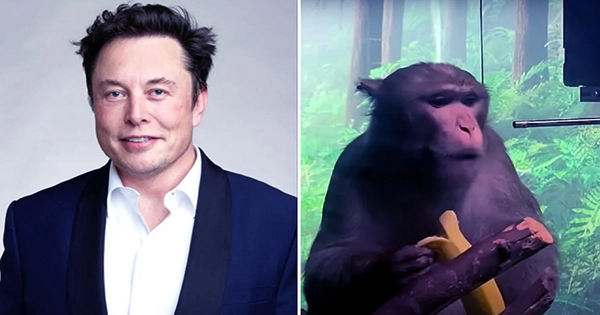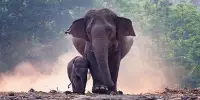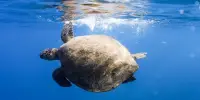On November 30, Elon Musk wants to have a “Show and Tell” event for Neuralink, his brain chip startup. However, a group of doctors alleges that Neuralink is “mutilating and killing animals” to construct “brain-machine interfaces.”
The company hosts the annual event, which Musk announced on Twitter, to exhibit its most recent developments. In the first Show and Tell in 2020, a pig was used to display the brain implant, and in 2021, a monkey who had the implant but later died had it used on him or her.
Earlier this year, the Physicians Committee for Responsible Medicine (PCRM) debuted a website describing the horrifying accounts of monkeys who allegedly suffered from careless studies at the University of California, Davis (UC Davis).
The lab notes from multiple studies carried out on monkeys that had had surgery to implant electrodes were provided by PCRM to DailyMail.com.
The texts identify Matthew MacDougall, the chief neurosurgeon of Nueralink, as the person “performing the procedures.”
The lab notes were given to the group by UC Davis as a result of a lawsuit PCRM filed against it in February, according to Reina Pohl, the communication specialist for PCRM, who also noted that Neuralink staff carried out the experiments.
According to the lawsuit, the monkeys were killed by BioGlue, which “killed them by damaging parts of their brains,” and the animals “suffered infections from the implanted electrodes placed in their brains.”
The studies were carried out at UC Davis, and Neuralink paid $1.4 million to utilize the university’s facilities, according to PCRM, which represents over 17,000 doctors.
Neuralink has stated that it carried out testing at the institution and has previously mentioned that numerous animals were put to death while participating in tests.
According to a post on the Neuralink blog, “two animals were put to death as part of this experiment at planned end dates to acquire vital histology data, and six animals were put to death at the medical advise of the veterinary personnel at UC Davis.”
Neuralink and MacDougall have been contacted by DailyMail.com for comment.
Although they failed to respond to the claims, UC Davis did give a link to a statement dated February.
According to the statement, “We fully cooperated with the California Public Records Act in responding to their request on the lawsuit by the Physicians Committee for Responsible Medicine.”
Indeed, following the end of the research agreement with Neuralink, further materials have been given to PCRM.
Eight tests performed at UC Davis are described in the February lawsuit, with each monkey given with a number.
According to the group’s website and lawsuit, this monkey entered the Neuralink program in 2018 and underwent surgery on September 10.
Animal 21 had an electrode implantation survivability treatment, which involves implanting electrodes in its brain, according to the lawsuit.
According to the record, the monkey was “repeatedly vomiting, gasping, retching and had very little engagement with environment/observers” just two days after the operation.
According to lab reports from personnel, the monkey appeared completely depleted three days after the treatment, and soon after, she was put to death.
According to PCRM, a necropsy revealed that the monkey’s declining health was caused by the usage of a substance called BioGlue, which was used to seal off holes in the animal’s skull and resulted in brain bleeding.
A surgical complication involving the use of the FDA-approved product (BioGlue) was acknowledged by Neuralink in its blog, and the monkey was put down.
According to the lawsuit, Animal 11 “died on March 15, 2019 at UC Davis in a terminal operation.”
Animal 11 was stated to have missing digits in lab notes, which PCRM claims were created by UC Davis workers. This was allegedly discovered in October 2018 before testing started.
The letter states that Animal 11 had a cranial implant on December 3, 2018, and that soon after the operation, the implant “got chronically infected.”
According to PCRM, the monkey had a “bloody skull” and “dried blood around the base at cranial implant” by January 2019.
Animal 15: A seven-year-old macaque used in the September 2017 Neuralink experiment
The website states that the studies on this monkey began in April 2018 while she was confined to a chair.
According to reports, “a recording device implant” was performed on this monkey on December 17, 2018.
The lawsuit asserts that “nearly immediately after” Animal 15 recovered from surgery, it started pulling and picking at its implant.
The implantation location developed an infection, just like the other animals.
Animal 15 was noted to be “shivering & scratching” four days after the procedure, and on December 28, Animal 15 shown signs of stress to some staff members.
According to the lawsuit, “the animal was sporadically administered antibiotics as well as probiotics for the following three months to try to address reoccurring infections, poor appetite, and watery diarrhea.”
According to reports, the monkey was put to death on March 21, 2019, and a necropsy revealed internal hemorrhage, “remaining electrode strands,” and “a focally torn cerebral cortex.”
Animal 12: a macaque of seven years old employed in research beginning in February 2018
According to the lawsuit, the drilling was done on July 17, 2018, not long after the monkey started having convulsions and had a lazy eye and conjunctivitis in both eyes.
When the monkey started “experiencing convulsions,” “an anticonvulsant was prescribed.”
Animal 12 was likewise not eating, and soon after, it got an eye infection.
According to reports, ketamine was used to tranquilize and kill Animal 12 on July 31.
Another monkey, referred to in the case as “Animal 10,” was sent to Neuarlink’s Fremont, California, facility despite having mental and physical problems, and shipping was authorized by staff.
Animal 10 developed minor lesions from picking at the implanted location and mild to moderate trauma, according to the shipping paperwork.
‘On October 1, 2020, personnel transported Animal 10 to Neuralink’s facility in Fremont, California by loading it into a crate. According to PCRM, nothing else is known about Animal 10 or his eventual outcome at Neuralink’s secret lab.















